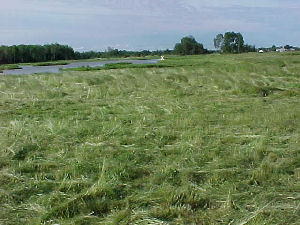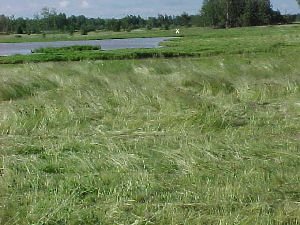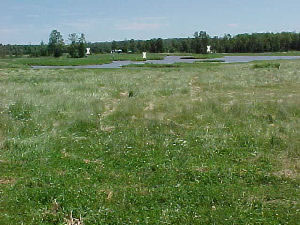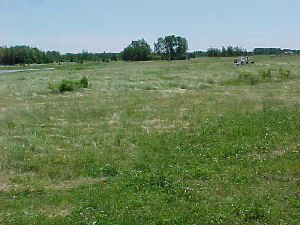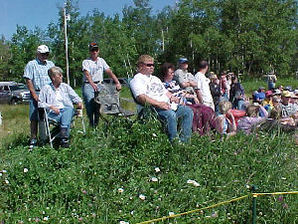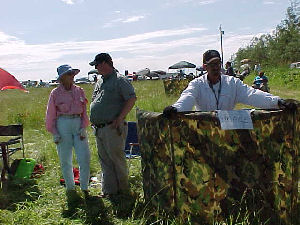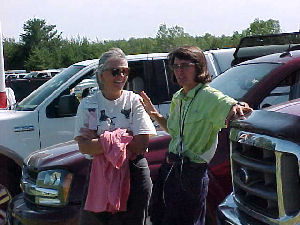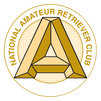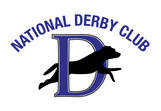Friday, June 24, 2005 |
Storms passed through the area with a reported tornado a few miles
from HQ.last night. In spite of that, Friday dawned clear and cool
without the opressing humidty of previous days. It was in the mid 60's
with a fresh breeze as the much smaller caravan travelled the 10 minute
trip to Dave Furin's property off 169.
TEST 7 - WATER BLIND
Off the road there was a large pond with a number of points, a spit and small islands. The Seventh test was a water blind along the right, irregular shoreline. The line was located just off the near side of the road with a hay bale behind it for handlers to use while directing their dogs. The shoreline was covered with recently mowed grass, but the far end, where the blind lay, had patches of uncut cover.
The line to the blind angled down a gentle slope to a finger of swimming water, then over the base of a spit into the water behind. It continued trough the swimming water a short distance to a point (actually the curving shoreline) . From there it was back into the water and over another point into a cove. Once through the cove, the dog arrived at the far shore where the blind, a dead duck was planted in front of a red marked bush 240 yards from line. There were 1 or 2 decoys in every piece of eater and 5 laying on the spit.Since it took a while to manicure the site the first test dog arrived on line at 7:45 a.m., the second at 7:53. It took about 5 mpd to complete. The first running dog, #23 ran at 8:15.
Dogs seemed to either want to enter the water "fat" or head toward the land on the right of the pond. That produced a number of early corrections. Some stopped to check the decoys on the spit and were quicly ordered to continue on. Most handlers blew whistles to put dogs on and drive the off the points. Some did continue on their own, however. The work was very similar throughout the series and it ended with dog #26 at 11:25 a.m.
Callbacks came quickly and only two dogs had been lost. They were 14 and 23. Thirty-seven happy handlers were invited back
The line to the blind angled down a gentle slope to a finger of swimming water, then over the base of a spit into the water behind. It continued trough the swimming water a short distance to a point (actually the curving shoreline) . From there it was back into the water and over another point into a cove. Once through the cove, the dog arrived at the far shore where the blind, a dead duck was planted in front of a red marked bush 240 yards from line. There were 1 or 2 decoys in every piece of eater and 5 laying on the spit.Since it took a while to manicure the site the first test dog arrived on line at 7:45 a.m., the second at 7:53. It took about 5 mpd to complete. The first running dog, #23 ran at 8:15.
Dogs seemed to either want to enter the water "fat" or head toward the land on the right of the pond. That produced a number of early corrections. Some stopped to check the decoys on the spit and were quicly ordered to continue on. Most handlers blew whistles to put dogs on and drive the off the points. Some did continue on their own, however. The work was very similar throughout the series and it ended with dog #26 at 11:25 a.m.
Callbacks came quickly and only two dogs had been lost. They were 14 and 23. Thirty-seven happy handlers were invited back
TEST 8 - WATER QUAD WITH TWO RETIRED GUNS
The eighth was quickly assembled and was ready for a test dog by 12:42,It was a quad consisting of an in line, indented triple across the same pond, but run from far up the right shore, with a flying hen pheasant to the right of the line. .
The first of the three across the water was located on the deep left, They threw a dead duck flat to the right that fell in grassy cover about 230 yards away. Closer in and to their right, a second set threw a dead duck to the right, over a slip of water where it landed on a curving spit of land about 210 yards from line. Deep to their right a third set (3) of guns shot twice and threw a dead duck flat and far to the right. It also landed in te grassy cover of the far shore, well over 300 yards away. On the near shore, a short distance to the right of the line Gunners shot a flying hen pheasant angled back to the left. It landed in fairly tall grass only 75 yards away. The order was: far right middle mark; short left middle spit bird;far left mark;short right flying hen pheasant. As the dog was sent for the flyer, the far left and far right gunners retired. Test dogs provided a mixed bag of information. The first handled on two while the second did well on all. At 1:19 the first running dog #46 stepped to line.
Early handlers tried to take the test in the same order as the successful test dog Flyer, Far right, left middle and far left.). That did not work well and all options were implemented. After the first five handled on one or two birds, Most decided the best chance was flyer, short left middle, far left, far right middle. That proved more successful and the sixth dog completed without handling.
The Flyer was no "gimmie" either. Wide, varied falls and a hen pheasants proved difficult for many and there were a number of fairly long hunts.Time spent doing so could dim a dog's memory of the 3 across the pond. Some started for the spit bird but drove through or past it. A few winded it but some did not , hunting wide and loose. Others were drawn to a rock on the right shore of the strip of land and arrived up wind of it.Those that drove deep could recover one of the long retired marks instead. Others put on long, wide out of sight hunts. It was nerve wracking for handlers and interesting for observers. Those having a clean job were given a round of applause. It took about 14 mpd and could not be completed today.
After dog 34 ran, the eighth was suspended for the day at 9:20 p.m There are 5 dogs left to run in the morning. Test dog will run at 6:45, first running dog, #36 at 7 a.m. No partial callbacks were given. Twelve of the 32 that had run had handled or picked up and there were a number of long, loose hunts. Number 8 was exacting a toll.
The first of the three across the water was located on the deep left, They threw a dead duck flat to the right that fell in grassy cover about 230 yards away. Closer in and to their right, a second set threw a dead duck to the right, over a slip of water where it landed on a curving spit of land about 210 yards from line. Deep to their right a third set (3) of guns shot twice and threw a dead duck flat and far to the right. It also landed in te grassy cover of the far shore, well over 300 yards away. On the near shore, a short distance to the right of the line Gunners shot a flying hen pheasant angled back to the left. It landed in fairly tall grass only 75 yards away. The order was: far right middle mark; short left middle spit bird;far left mark;short right flying hen pheasant. As the dog was sent for the flyer, the far left and far right gunners retired. Test dogs provided a mixed bag of information. The first handled on two while the second did well on all. At 1:19 the first running dog #46 stepped to line.
Early handlers tried to take the test in the same order as the successful test dog Flyer, Far right, left middle and far left.). That did not work well and all options were implemented. After the first five handled on one or two birds, Most decided the best chance was flyer, short left middle, far left, far right middle. That proved more successful and the sixth dog completed without handling.
The Flyer was no "gimmie" either. Wide, varied falls and a hen pheasants proved difficult for many and there were a number of fairly long hunts.Time spent doing so could dim a dog's memory of the 3 across the pond. Some started for the spit bird but drove through or past it. A few winded it but some did not , hunting wide and loose. Others were drawn to a rock on the right shore of the strip of land and arrived up wind of it.Those that drove deep could recover one of the long retired marks instead. Others put on long, wide out of sight hunts. It was nerve wracking for handlers and interesting for observers. Those having a clean job were given a round of applause. It took about 14 mpd and could not be completed today.
After dog 34 ran, the eighth was suspended for the day at 9:20 p.m There are 5 dogs left to run in the morning. Test dog will run at 6:45, first running dog, #36 at 7 a.m. No partial callbacks were given. Twelve of the 32 that had run had handled or picked up and there were a number of long, loose hunts. Number 8 was exacting a toll.


